Let there be light, and some fresh air too! One of the distinguishing features of most traditional clerestory-roofed railroad cars is the clerestory window. Designed to provide both light and ventilation, the windows are typically elongated and have hinges that allow the windows to “roll” into the car.
Chapel car 5 – built in 1898 in an era before air conditioning – was built with 45 clerestory windows. These windows were constructed of white oak and were glazed with double glue chip glass. Fortunately, these windows were in comparatively good condition and 38 original windows arrived in Snoqualmie with the car. Unfortunately, nearly all the bottom rails were badly deteriorated and some of the glazing was broken or had been replaced with other types of glass.
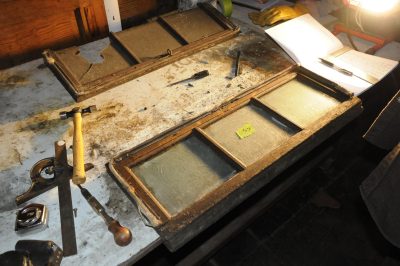
Old shellac was removed with the infrared stripper and then alcohol. Glass and stop material was carefully removed and saved.
Work began in February 2011 with the removal, cataloging, and condition assessment of all the windows. Over a period of months hardware was recovered, glazing was removed, paint and shellac was stripped, and new stiles and rails were made and exchanged as required. Seven completely new window frames were made, and a new weather stripping reveal to hold a rubber strip against the bottom swivel face was made for all 45 windows. The window frames were cleaned and sanded, and then set aside until the car body was completed. The hardware and glass were carefully cleaned and set aside for reuse.
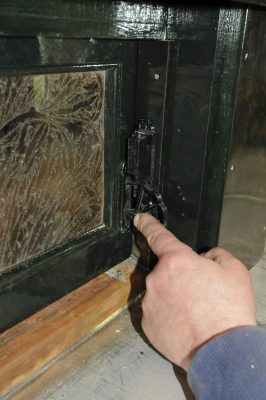
Hardware consists of a spring-loaded latch and a radius with detents to hold the window in a given position.
Hardware is easily taken for granted but without it the windows never would have performed their function. The hinges and pivots were assemblies originally produced by the Dayton Manufacturing Company, the hardware company owned by Barney and Smith. Some windows had slightly more modern assemblies made by Adams and Westlake, a company still in business today as Adlake! Regardless of origin, all hardware was “cooked” overnight in a dilute soap solution. Each item was then lightly brushed to remove varnish, paint and rust. The hardware was coated with a gun-metal paint color. Many of the mounting screws were replaced in kind with steel flathead slot screws each individually painted black to match.
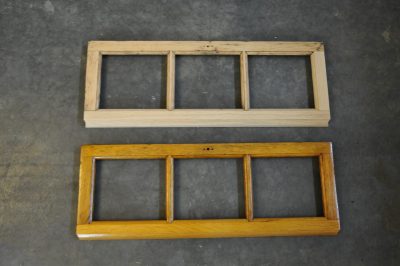
Shellac immediately changes the appearance of the windows.
In winter 2011, “varnishing” of the windows began. Traditional shellac (flakes dissolved in alcohol) was applied in successive 3 lb/gallon coats until a smooth and uniform finish was achieved – typically that required eight coats with light sanding between each coat. Shellac dries quickly and recoating is typically after 8 hours, but it is dry to the touch in 15 minutes or less.
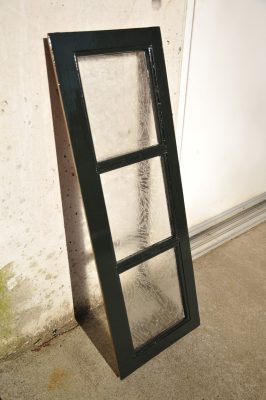
The exterior was painted with a dark green urethane matched to paint samples found under the end platform hood.
After the varnish process was completed, the outside of the frame received primer. Then the windows were glazed and the final coats of dark green were applied to the exterior.
Window installation was tricky: care had to be used to set the hinges in exactly the right location so the windows are neither too tight
nor too loose. Evidence that this had been a problem in the past was a serious of metal clips that had been fashioned and installed over the clerestory hinges to prevent the windows from quite literally bouncing out on rough track! This
problem was exacerbated when windows were removed for servicing (typically a fresh coat of varnish) and were not reinstalled in the same openings they came out of. With careful installation in the openings that match the numbers on the window, the Museum expects a more precision fit and does not plan to reinstall the “aftermarket” clips.
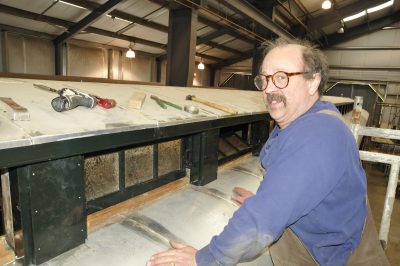
Lead restoration worker Kevin P. highlights the first clerestory windows to be reinstalled.
So many hundreds of hours later, chapel car 5 Messenger of Peace has 45 rehabilitated or restored clerestory windows installed. The car had one of its distinguishing features returned to its former glory and another category of work is completed.







Spike, What a dedicated and focused group of volunteers. The Northwest Railway Museum is fortunate to have such a great and talented group working on the rehabilitation of the Chapel Car. Take Care, Big Daddy Dave
Thanks, David! We have a great group of volunteers that do everything from run the train, to fix the track and give tours. We also have a great group of professional staff that are making things like new buildings possible. And several highly skilled tradespeople are working full time on the chapel car and were responsible for about 2/3 of the effort on the clerestory windows. Thanks for your comments.
–Spike